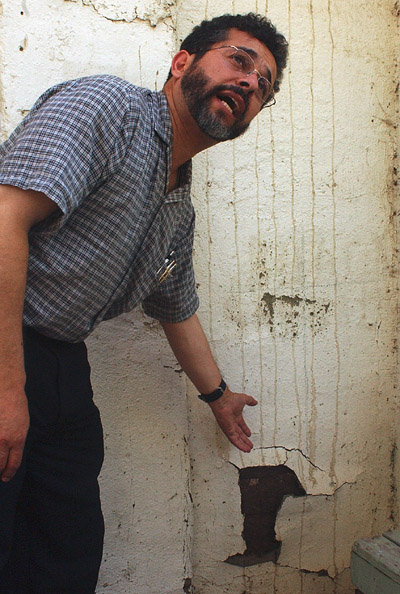
For the Old Mission San Juan Bautista, a little money went a
long way in funding a project Father Edward Fitz-Henry has been
working on since the beginning of summer – renovating and
landscaping an area in front of the Mission.
When people visit the Mission they are encouraged to leave a $2
donation at the gift shop, Fitz-Henry said.
For the Old Mission San Juan Bautista, a little money went a long way in funding a project Father Edward Fitz-Henry has been working on since the beginning of summer – renovating and landscaping an area in front of the Mission.
When people visit the Mission they are encouraged to leave a $2 donation at the gift shop, Fitz-Henry said.
“Some give more, some give nothing, but that money is collected each week and put aside,” he said.
For the past several years that money has been accumulating and now totals almost $200,000, he said.
“It’s the small amounts that make a difference,” he said. “Because we can’t rely on state or federal money, we rely on private donations.”
The renovations will occur in an area in front of the Mission that overlooks the valley below, where soil erosion has created a safety hazard for visitors, said California State University, Monterey Bay archaeologist Ruben Mendoza, who specializes in the California Missions.
A retaining wall will be built, a Native American-themed garden planted and the entire area will be hardscaped, he said.
The project, which will deplete Fitz-Henry’s “garden fund,” will concentrate on an area only 60 by 100 square feet. When restoring portions of the Mission, a large sum of money doesn’t go very far, Mendoza said.
The Mission garnered publicity recently when Rep. Sam Farr, D-Carmel, visited, promoting a bill he is co-sponsoring that will, if passed, apportion $10 million to the 21 missions over five years.
If the bill passes it will not guarantee Mission San Juan Bautista gets the monetary assistance that many portions of the site are in dire need of.
“When people think $10 million, they think we’re getting all of it, but we’re not,” Fitz-Henry said. “We would have to apply for grants. We could get a lot, or we could get nothing because it’s based on the most important needs for all the missions.”
Any money the Mission receives will go toward retrofitting and renovating the fabric of the church, not for liturgy and rituals, Fitz-Henry said.
“We don’t card people at the door, asking, ‘Are you a Catholic, do you believe or don’t you,'” he said. “We focus not on Catholics but on the historical aspects, people of all faiths and from all over the world come to see this beautiful place.”
Nothing the Mission raises is controlled by the Catholic Church, but rather by an independent board separate from the Church or the California Mission Foundation.
The California Mission Foundation, founded in 1998, is a private, non-profit organization. It was established by Richard Ameil, an eighth generation Californian and descendant of original Spanish settlers who came to California in 1774, according to the foundation’s Web site.
The foundation, of which Mendoza is a board member, has helped aid the Mission with grant money and donations which total almost $40,000. Conservators, historians, archaeologists and other specialists sit upon the foundation’s board, Mendoza said.
The Mission attracts thousands of visitors every year, not to mention the 40,000 to 60,000 school children who visit as part of the state’s fourth- and seventh-grade curriculum, Fitz-Henry said.
Mendoza’s first visit to the Mission was on a school field trip in fourth grade, and it inspired his interest in education and history, he said.
“Coming here I felt like I’d somehow stepped into the Old West,” he said. “I started scanning books and from there my interest in archaeology stemmed, and now I have a Ph.D.”
Growing up in Fresno, he wasn’t predisposed to school and studying, and was vulnerable to the street influence. The nature and lure of the Mission turned him around, he said.
“Every now and then I stand out there in front and feel a strong sense of deja vu,” he said, “like I’ve been catapulted back to fourth grade.”
The importance of the Mission is undeniable, chronicling years of California’s history and should be safeguarded so that history can be used throughout the years to educate and enthrall, Fitz-Henry said.
“This mission means a lot to people,” he said. “Everyone would agree this is a place worth preserving.”









